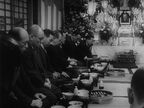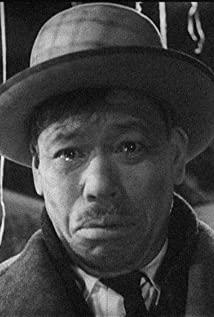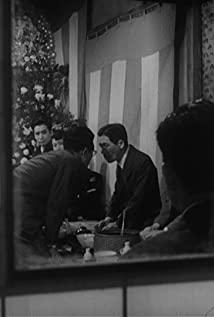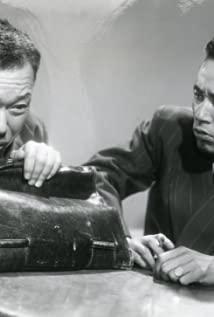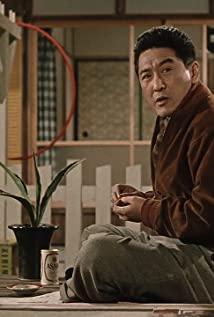"The Desire of Life" is a film made by Akira Kurosawa in 1952. It mainly tells the story of how a Japanese civil servant who is about to die re-lives his life and finds the meaning of life. Many people have talked about the subject of the film, and I will talk about the film's excellent cinematography and soundtrack.
1. Watanabe, played by Takashi Shimura, knew that he had stomach cancer. After leaving the hospital, you found that Akira Kurosawa had created a completely quiet scene, and the picture was matched with Watanabe, walking silently hunched over. Until he hit the road, the whistle pulled him back to the real world.
The good thing here is that the picture is completely silent when you are walking. When you learned about the great sorrow of life, you were deaf, withdrawn, walking in the world like a walking dead. At this time, you can't hear what is being said outside, because in the quiet There are huge waves rolling in my heart.
2. When you go home, your son and daughter-in-law are walking and talking, and you find that Akira Kurosawa did not point the camera at the son and daughter-in-law, but only pointed the camera at the door. With the sound of footsteps, the camera moved forward step by step, like a ghostly scene, just like Hitchcock's famous movie "The Butterfly Dream".
3. The son and daughter-in-law hugged in the next room, and cut to Watanabe's side, there was still no bgm, only the sound of hands rubbing the air. At this time, silence is better than sound, and this completely quiet loneliness is especially well shaped. The sound of the son and daughter-in-law's announcement in the next room slowly revealed from the back. At this time, Watanabe was happy, but only borrowed happiness, just as the singing was borrowed from the next wall.
Modern people like to listen to podcasts more and more, and they have to turn on the stereo when they get home. The loneliness of no one around is like what we have experienced, once bgm, the emptiness instantly occupies the heart.
4. A slew of great shot-cut tricks every director should check out.
First, the camera shows the photo of the deceased wife, the camera switches to the scene when the wife died, and then freezes on the wife's hearse. The shape of the hearse is the same as the wife's shrine. The same shape objects are switched shots, and then switched to reality. At this time Watanabe called his son.
The camera cuts to a friend who persuades him to remarry. The reality meets the past. When he hears the child's voice, Watanabe knelt on the stairs and called for his son.
At this time, there was only the sound of Watanabe's footsteps, returning to the room. Hearing the wind, pressed a baseball bat against the door. Switching to the same object, switching to the baseball game when the child was a child, the result failed, and Watanabe called his son.
The same drop-off scene before and now cuts to his son who cuts his appendix, and Watanabe calls his son.
The eyes and the camera switched, his son joined the army, although he was reluctant, but along with the train away, Watanabe called his son.
The scene frame transitions, the train switches to the stairs, and Watanabe is lying on the stairs, climbing up and up again.
The camera cut ends.
The camera cuts here are dazzling, but not dazzling. Akira Kurosawa used such a continuous switching shot to film the intersection of the life of the father and the child. But at the end of each paragraph, the father is calling for the son, but the son is far away from each paragraph. In the end, the father climbed the stairs and climbed down again, after all, he did not communicate with his son. It felt like drowning, I couldn't catch anything, and my son was somewhere far away, leaving me alone to struggle.
5. Later, Watanabe used the way of playing the world to go to the Fengyue place to hang out. At this time, there is bgm in the picture, but you know very well that this bgm is borrowed. When Watanabe is alone, there will be only footsteps. Prove that previous rescue methods have failed.
It was not until he met the young girl in the office that Watanabe had his own bgm for the first time, and his heart was no longer empty.
6. In the last 50 minutes, Watanabe had already made it clear that the funeral scene appeared early. Some people asked why the funeral was arranged so early? Because if shot in chronological order, the film would be reduced to showing Watanabe's humbleness and the difficulty of doing things. And they are all homogenous seekers. It is better to use the transition again and again to connect the previous ordeals. But the point is not to show the ordeal, but to see the reaction of the office staff after the ordeal.
But it was a falsehood. After drinking, he shouted out his ideals. When he was sober, he still played football as usual.
But at least one other person was touched by Watanabe, and children played in the park benefiting from Watanabe's work. At that moment, the sky was clear and the sky was clear, and Watanabe finally broke the joke at the beginning of the movie. "I have never asked for leave. It's not that I need me here, but that I can do without me."
View more about Ikiru reviews




